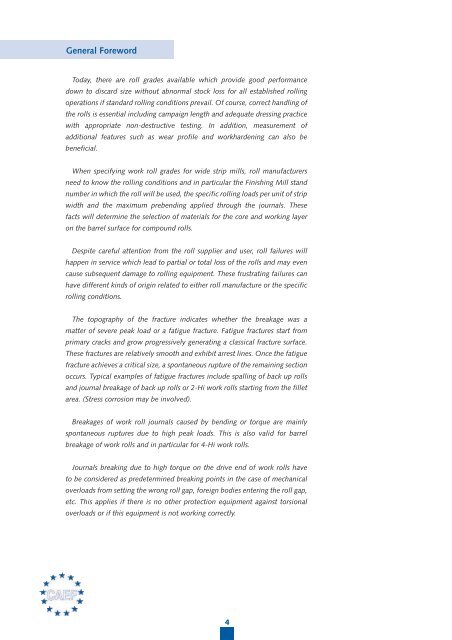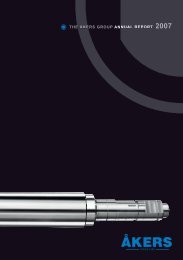CAEF Roll failures manual - The Åkers Group
CAEF Roll failures manual - The Åkers Group
CAEF Roll failures manual - The Åkers Group
You also want an ePaper? Increase the reach of your titles
YUMPU automatically turns print PDFs into web optimized ePapers that Google loves.
General Foreword<br />
Today, there are roll grades available which provide good performance<br />
down to discard size without abnormal stock loss for all established rolling<br />
operations if standard rolling conditions prevail. Of course, correct handling of<br />
the rolls is essential including campaign length and adequate dressing practice<br />
with appropriate non-destructive testing. In addition, measurement of<br />
additional features such as wear profile and workhardening can also be<br />
beneficial.<br />
When specifying work roll grades for wide strip mills, roll manufacturers<br />
need to know the rolling conditions and in particular the Finishing Mill stand<br />
number in which the roll will be used, the specific rolling loads per unit of strip<br />
width and the maximum prebending applied through the journals. <strong>The</strong>se<br />
facts will determine the selection of materials for the core and working layer<br />
on the barrel surface for compound rolls.<br />
Despite careful attention from the roll supplier and user, roll <strong>failures</strong> will<br />
happen in service which lead to partial or total loss of the rolls and may even<br />
cause subsequent damage to rolling equipment. <strong>The</strong>se frustrating <strong>failures</strong> can<br />
have different kinds of origin related to either roll manufacture or the specific<br />
rolling conditions.<br />
<strong>The</strong> topography of the fracture indicates whether the breakage was a<br />
matter of severe peak load or a fatigue fracture. Fatigue fractures start from<br />
primary cracks and grow progressively generating a classical fracture surface.<br />
<strong>The</strong>se fractures are relatively smooth and exhibit arrest lines. Once the fatigue<br />
fracture achieves a critical size, a spontaneous rupture of the remaining section<br />
occurs. Typical examples of fatigue fractures include spalling of back up rolls<br />
and journal breakage of back up rolls or 2-Hi work rolls starting from the fillet<br />
area. (Stress corrosion may be involved).<br />
Breakages of work roll journals caused by bending or torque are mainly<br />
spontaneous ruptures due to high peak loads. This is also valid for barrel<br />
breakage of work rolls and in particular for 4-Hi work rolls.<br />
Journals breaking due to high torque on the drive end of work rolls have<br />
to be considered as predetermined breaking points in the case of mechanical<br />
overloads from setting the wrong roll gap, foreign bodies entering the roll gap,<br />
etc. This applies if there is no other protection equipment against torsional<br />
overloads or if this equipment is not working correctly.<br />
4




